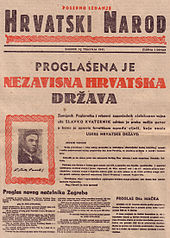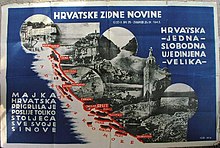Independent State of Croatia
![]()
This article is about a historical state at the time of World War II. For the currently existing Republic of Croatia, see Croatia.
Template:Infobox State/Maintenance/NAME-German
Independent State of Croatia (Croatian: Nezavisna Država Hrvatska, abbreviated NDH), abbreviated USK, is the name for the Croatian vassal state of the Axis powers during the Second World War, existing from 1941 to 1945. The USK was under the leadership of the dictator Ante Pavelić (1889-1959) and his fascist Ustasha movement.
The USK came into being after the German Balkan campaign (1941) and the partition of the Kingdom of Yugoslavia by the German Reich and the Kingdom of Italy. The declared territory of this large Croatian state was parts of present-day Croatia (without Istria and until 1943 without parts of Dalmatia), the whole of Bosnia and Herzegovina and parts of present-day Serbia (Syrmia). Thus it had a total of 6.3 million inhabitants, of which 3.3 million were Croats, 2 million Serbs, 700,000 Muslims and 150,000 "ethnic Germans".
German and (until 1943) Italian occupation forces were stationed on the territory of the USK, supported by allied Croatian forces. The USK adopted the Nuremberg Laws mutatis mutandis and engaged in the systematic persecution and murder of ethnic minorities such as Serbs, Jews and Roma, and members of the opposition. The internal conflicts within the USK, which existed from the beginning, also reached government agencies in the end (Lorković-Vokić conspiracy). With the German defeat in 1945, the USK could no longer withstand the military superiority of the communist Tito partisans.
Origin
After Yugoslavia's accession to the Three-Power Pact, there had been a British-backed coup by Serbian officers against Prince Regent Paul. The new Yugoslav government tried to come to an agreement with the German Reich, but the latter launched the Balkan campaign, an attack on Yugoslavia and Greece, on 6 April 1941. The alliance agreement concluded with the Soviet Union the day before was no longer effective, and on April 17 the Yugoslav forces capitulated. Already on April 10, Holy Thursday of that year, the Wehrmacht marched into Zagreb, whereupon Colonel Slavko Kvaternik proclaimed the Independent State of Croatia in the name of the Ustasha movement with the following words - referring to the imminent Easter:
"God's providence and the will of our great ally, as well as the centuries-long struggle of the Croatian people and the great sacrifice of our leader Dr. Ante Pavelić and the Ustasha movement at home and abroad, have arranged that today, before the resurrection of the Son of God, our independent state of Croatia also rises.
I call upon all Croats, especially officers, non-commissioned officers and enlisted men of the armed forces and public security organs, to maintain
peace and order. The armed forces are to state their whereabouts and immediately take the oath to the Independent State of Croatia and its Poglavnik.
I have assumed command of all armed forces today as the commissioner of the Poglavnik.
God with the Croats! Ready for the Fatherland!"
![]()

Special edition of the newspaper Hrvatski Narod (The Croatian People) of 10 April 1941 with the headline: "Proclamation of the independent Croatian state".
Geography
According to the Minister of Foreign Affairs, Mladen Lorković, the Independent State of Croatia owed its border demarcation "above all [...] to the generous friendship of the German Reich and Fascist Italy." Significantly, in Ante Pavelić's study, next to the picture of the Duke and Duchess of Spoleto, hung the pictures of Mussolini and Hitler.
In addition to the Croatian core areas (Croatia, Slavonia), the national territory also included Bosnia and Herzegovina as well as Syrmia. With the ratification of the "Roman Protocols", the western border of the USK with Italy was defined: the area from Sušak to Kraljevica with a small hinterland fell to Italy, then the coast up to Obrovac to Croatia, further south the coastal area at a maximum depth of 40 km (including Šibenik and Trogir) again to Italy, plus the islands of Krk, Rab and Vis as well as the area of Kotor. The island of Pag and the coast from Trogir only up to and including Dubrovnik remained with Croatia. The territories annexed by Italy had an area of 5,400 km² with 380,000 inhabitants (of whom 280,000 were Croats, 90,000 Serbs and 5,000 Italians). They were particularly valuable both strategically and economically and occupied a prominent place in Croatian national consciousness. The Croatian government tried unsuccessfully to avoid the loss of Dalmatia by offering the Croatian crown to an Italian prince and other political concessions. By announcing this agreement, the Ustaša government quickly lost popular support.
Mladen Lorković, as former foreign and later interior minister, justified the cession of the territories:
"Assuming a loyal execution of the Treaties of Rome from one side and the other, the Croatian Government was entitled to entertain the hope that Croatian-Italian relations should thus develop in an atmosphere of friendship, so that one day, at the latest after the end of this war, the question of frontiers might be submitted to a review in favour of Croatia."
After the capitulation of Italy in 1943, the Italian annexed territories fell to the Independent State of Croatia.

The coastal areas ceded to Italy from 1941 to 1943.

Propaganda poster for the reintegration of the Croatian coastal areas after the capitulation of Italy (1943)
Questions and Answers
Q: What was the Independent State of Croatia?
A: The Independent State of Croatia was a fascist/nazi puppet-state during World War II.
Q: When was the Independent State of Croatia established?
A: The Independent State of Croatia was established in April 1941.
Q: Who ruled the Independent State of Croatia?
A: Ante Pavelić and his Ustaše - a racist, terrorist and saboteur organization - ruled the Independent State of Croatia.
Q: What was the program formulated by Mile Budak?
A: The program formulated by Mile Budak aimed to purge Croatia of Serbs, by "killing one third, expelling the other third and assimilating the remaining third."
Q: What was the planned genocide during WWII in Jasenovac concentration camp?
A: The planned genocide during WWII in Jasenovac concentration camp was part of the program to purge Croatia of Serbs.
Q: What territories did the Independent State of Croatia encompass?
A: Geographically, the Independent State of Croatia encompassed most of modern-day Croatia as well as all of Bosnia and Herzegovina and parts of Slovenia and Serbia.
Q: What was the Pure Party of Rights founded by Ante Starčević?
A: The Pure Party of Rights founded by Ante Starčević was a far-right Croatian nationalist and anti-Serb political party at the end of the 19th century.
Search within the encyclopedia